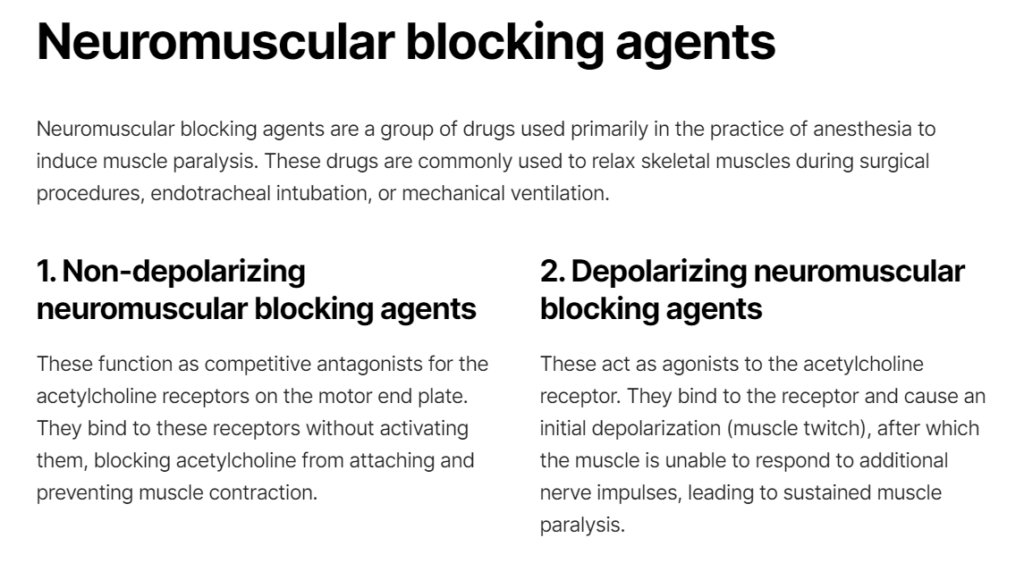Table of Contents
Neuromuscular blocking agents and skeletal muscle relaxants
Neuromuscular blocking agents and skeletal muscle relaxants are two types of medications that act on the muscular system, but they have different uses and mechanisms of action.
Neuromuscular blocking agents
Neuromuscular blocking agents are a group of drugs used primarily in the practice of anesthesia to induce muscle paralysis. These drugs are commonly used to relax skeletal muscles during surgical procedures, endotracheal intubation, or mechanical ventilation.
Neuromuscular blocking agents work by interfering with the transmission of nerve impulses at the neuromuscular junction, the synapse between a motor neuron and a muscle cell. They essentially block the effects of acetylcholine, a neurotransmitter that normally triggers muscle contraction.
Types of neuromuscular blocking agents
There are two main types of neuromuscular blocking agents: non-depolarizing and depolarizing.
1. Non-depolarizing neuromuscular blocking agents
These function as competitive antagonists for the acetylcholine receptors on the motor end plate. They bind to these receptors without activating them, blocking acetylcholine from attaching and preventing muscle contraction. Drugs in this category include rocuronium, vecuronium, and pancuronium.
2. Depolarizing neuromuscular blocking agents
These act as agonists to the acetylcholine receptor. They bind to the receptor and cause an initial depolarization (muscle twitch), after which the muscle is unable to respond to additional nerve impulses, leading to sustained muscle paralysis. The most common example of a depolarizing neuromuscular blocking agent is succinylcholine.
The use of these drugs must be closely monitored because of the potential for serious side effects, such as respiratory failure if the patient is not properly ventilated. The effects of non-depolarizing agents can be reversed with certain drugs (neostigmine, for example), while depolarizing agents must naturally wear off.
Skeletal muscle relaxants
Skeletal muscle relaxants are a diverse group of medications that are used to relieve muscle spasms, spasticity, or other muscle-related discomfort. They’re often used in conjunction with rest and physical therapy to treat conditions such as muscle sprains, strains, or back pain, as well as certain neurological conditions like multiple sclerosis.

Categories of skeletal muscle relaxants
Skeletal muscle relaxants can be broken down into two main categories based on their site of action: centrally acting and peripherally acting muscle relaxants.
1. Centrally acting muscle relaxants
It work on the central nervous system to relax muscles. They don’t act directly on the muscles themselves but rather reduce muscle tone by affecting the nerves that control muscle contraction. Some of these drugs can also have sedative effects. Examples include carisoprodol (Soma), cyclobenzaprine (Flexeril), and methocarbamol (Robaxin). The exact mechanism of action for many of these drugs isn’t entirely understood, but many are believed to work, at least in part, by sedating the user or reducing the transmission of certain signals in the central nervous system.
2. Peripherally acting muscle relaxants
It act directly on muscle tissue to reduce muscle contraction. These are much less common than centrally acting relaxants. An example is dantrolene (Dantrium), which is used to treat conditions such as spasticity due to spinal cord injury, cerebral palsy, or multiple sclerosis. Dantrolene works by interfering with the release of calcium ions in muscle tissue, which is a crucial step in muscle contraction.
It’s important to note that while neuromuscular blocking agents can also cause muscle relaxation, they’re not typically classified as muscle relaxants. Neuromuscular blocking agents cause a much more profound level of muscle paralysis and are used in different clinical settings, such as during general anesthesia for surgery.


